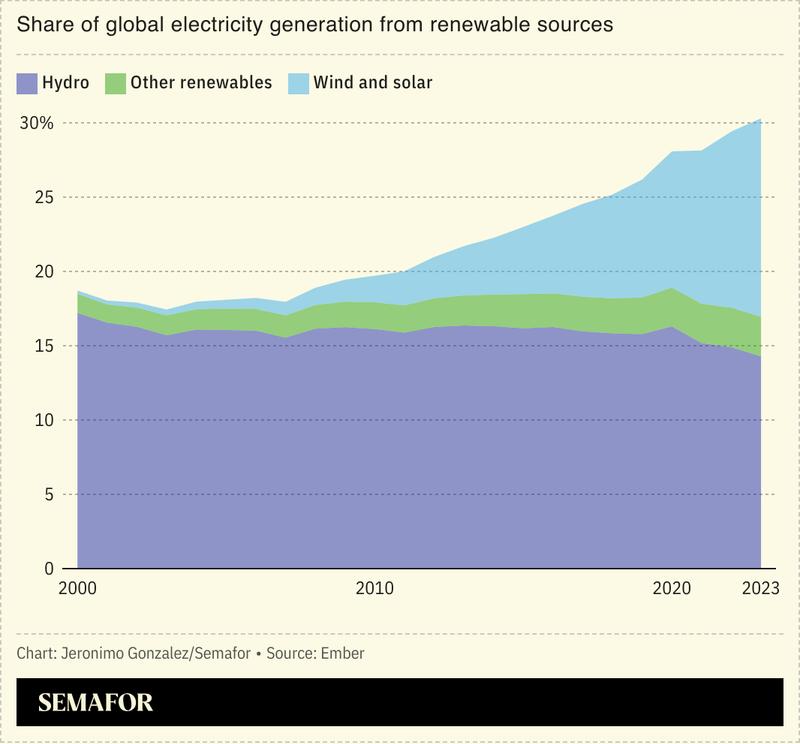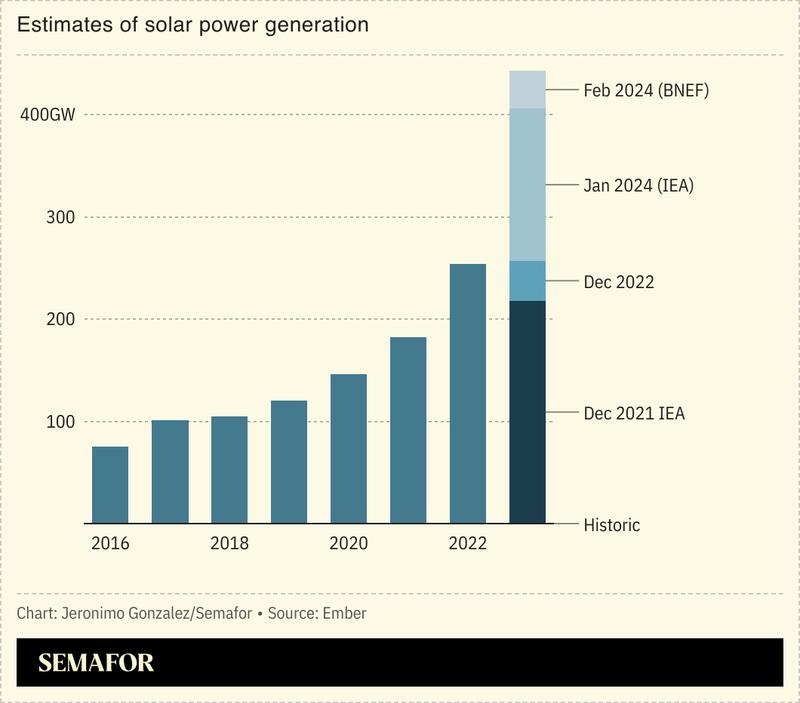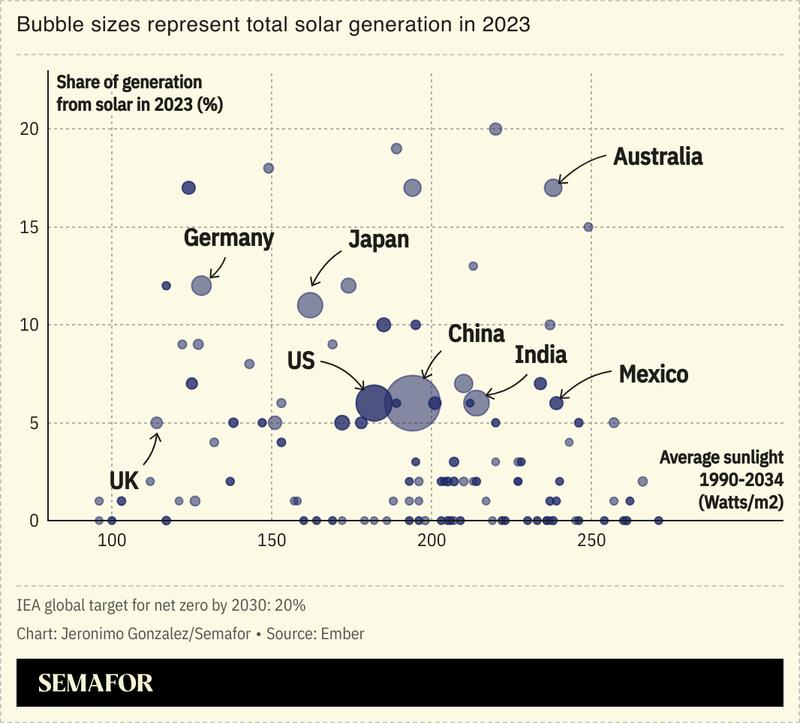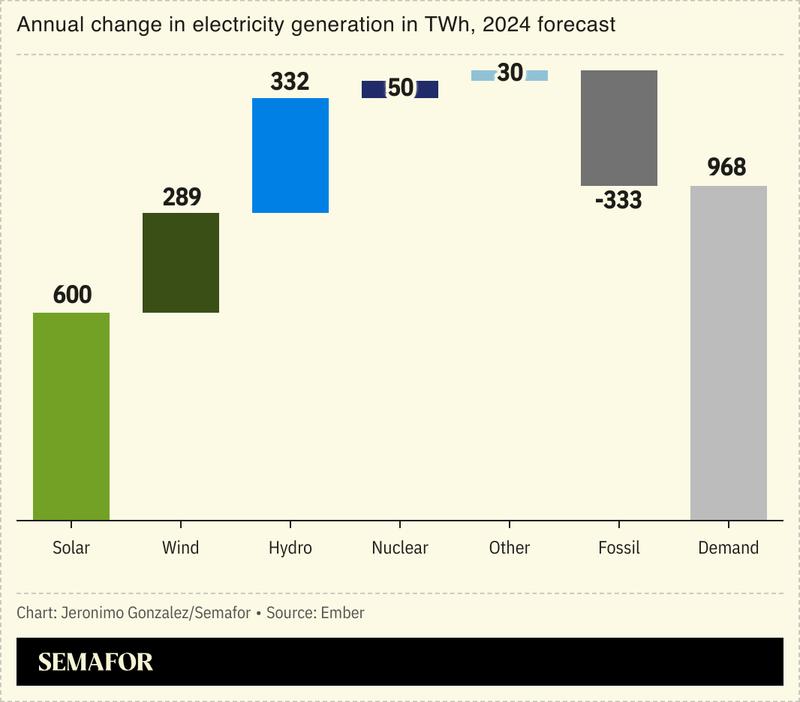The Author
Dave Jones is the Global Insights Program Director at Ember, an energy think tank headquartered in London.
In this article:
The News
The world reached a huge milestone in 2023: Renewable sources accounted for 30% of global electricity for the first time. That’s the biggest takeaway from the annual report produced by the energy think tank where I work, Ember.
The rapid growth in solar and wind power has brought the world to a crucial pivot point — likely this year — where fossil fuel-powered generation will start to decline at a global level.
As a result, 2023 will likely go down in history as the peak of emissions in the power sector. That’s incredibly positive news. Fossil fuels may still generate 61% of the world’s electricity, but the renewables future is coming into sight. And faster than you think.
But there’s still a long way to go. The pace of emissions falling — and what that means for efforts to keep temperature increases within the world’s 1.5 degree Celsius target — depends on how fast this renewables revolution goes.
Here are five things you need to know from our landmark report.
Know More
1. The renewables future has arrived

Growth in building out solar and wind pushed the world past 30% renewable electricity last year for the first time ever.
The pace of change is astonishing. Hydropower has historically been the dominant source of the world’s renewable electricity, providing around a sixth of the world’s electricity in the last two decades. But the newcomers on the scene — solar and wind — are driving all the recent growth. Together, they generated a record 13% of global electricity in 2023, double what they accounted for in 2017.
Last year also brought clean energy and fossil fuels into competition like never before: In 2023, for the first time, global investment in solar topped investment in oil production.
2. Solar is growing faster than anyone thought possible

The growth in solar capacity installed in 2023 was truly off the scale.
The prior year already saw record levels of solar-power installations, breaking 200 gigawatts for the first time. Last year smashed that with 444 GW, topping virtually every credible forecast. As recently as 2022, the International Energy Agency forecast only 257 GW.
The continued supply of cheap solar meant that it maintained its status as the world’s fastest-growing source of electricity generation for the 19th consecutive year.
China is leading the charge. The country installed more solar panels in 2023 than the US has in its entire history. Clean energy was the top driver of China’s economic growth in 2023. For other fast-growing solar markets like South Africa, a secure supply of electricity is a major motivating factor.
3. The best is still yet to come with solar

Solar power is taking off around the world, but many sunny countries have still yet to harness its potential.
Six countries generated at least a sixth of their electricity from solar last year. Some intuitively make sense: Chile topped the table with 20% of its electricity coming from solar in 2023, up from just 2% in 2015. Others are surprising. The Netherlands — not known as a particularly bright or warm place — ranked fourth, proving that it’s not the sun that matters, but enabling policies.
Those examples show how much further the solar boom has to go. Countries like Egypt, Pakistan, and Saudi Arabia still generate less than 3% of their electricity from solar, despite some of the best conditions in the world. For sunny regions like Africa, overcoming financial barriers will be crucial.
The early adopters of solar are proving that whether you are a sunny country or not, solar can rapidly become a major source of cheap, clean electricity.
4. A down year for wind

Solar’s sidekick has had a tougher year, with weak Midwest breezes in the US a key cause of slower-than-expected growth in the world’s wind generation in 2023.
But long-term trends suggest that the recent blip won’t hold back wind power. Overall wind generation still reached a new record high in 2023, tripling since 2015. Like with solar, China continues to lead, installing 65% of the global wind-power capacity added during 2023.
Despite concerns that the industry is struggling, its long-term outlook nevertheless looks encouraging: The offshore wind industry is overcoming its inflationary and planning problems, though cheap onshore wind remains largely untapped.
Wind doesn’t need the same rapid trajectory as solar to put the world on course for net zero. But it will be crucial to rapidly replacing fossil fuels, and needs to become the backbone alongside solar of the future clean electricity system.
5. The fossil fuel-power era is ending

A new era of falling fossil generation is imminent. 2023 will likely go down in history as the peak of emissions in the power sector.
The rapid growth in solar and wind has brought the world to this crucial pivot point. Solar and wind have already helped to slow the growth in fossil generation over the last decade, and 2024 will bring a bumper year of renewable generation, with the rise in solar generation set to double from the previous year.
A long-term decline in power sector emissions is now not just inevitable but imminent, even as the world enters a new phase of higher electricity demand as we electrify all manner of technologies from transportation to heating.
The pace of emissions falls still depends on how fast the renewables revolution continues. It’s a big task, but the costs are far outweighed by the benefits — a liveable planet, with cheaper and more secure energy.


